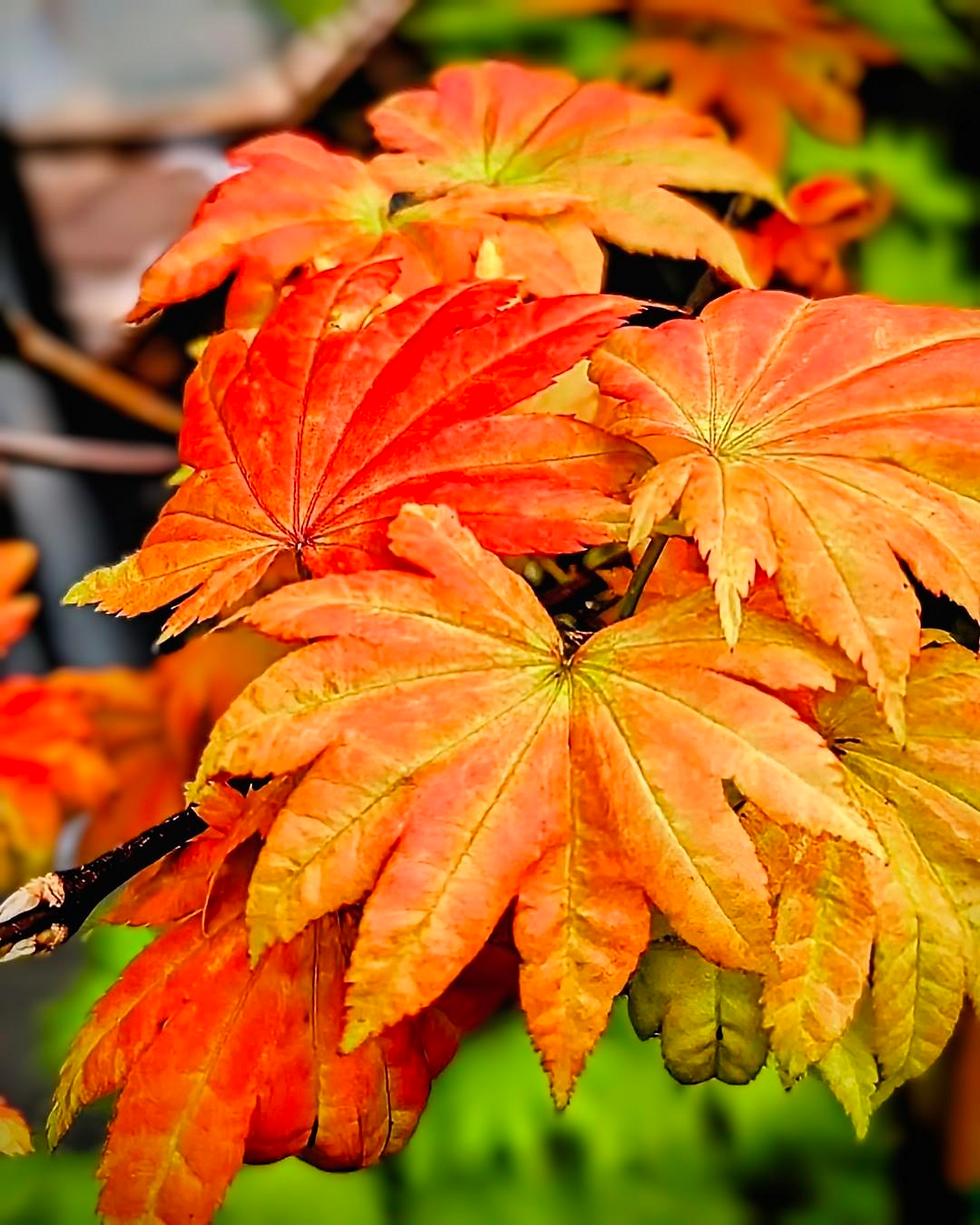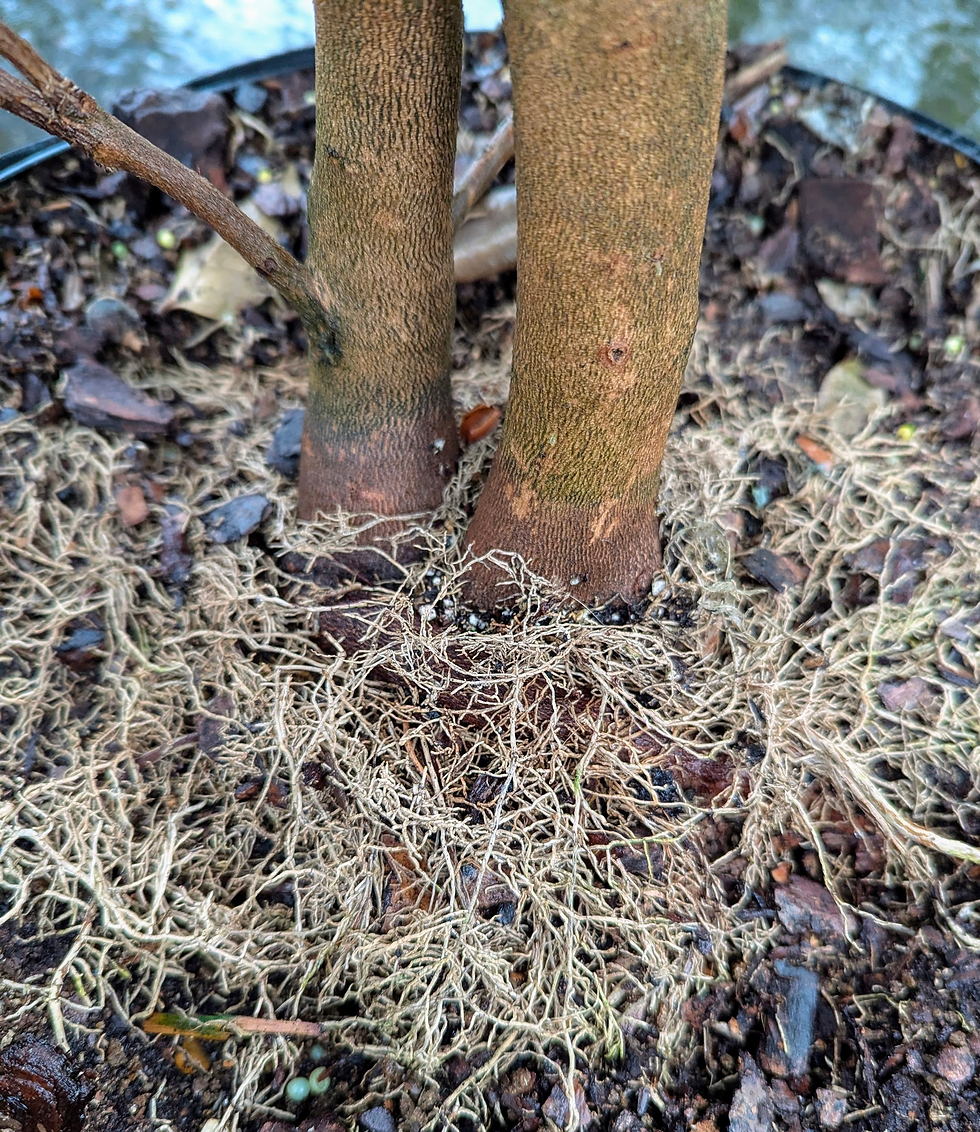Fall Planting Guide: Shrubs and Trees
- Adriana Marsh
- Aug 29
- 7 min read
Fall Planting Guide: Shrubs and Trees
As a gardener, I cherish fall for its ideal planting conditions – cooler temperatures, gentle rainfall, and warm soil.
In this guide, discover tips on planting timing, soil preparation, and post-planting care.
Planting a shrub or tree requires careful attention to detail to ensure a strong foundation for future growth. Follow these steps to give your plants the best start.

Step-by-Step Planting Guide
Pre-Planting
1. Choose a location with suitable sunlight, soil, and space for mature growth.
2. Prepare the soil by removing debris, weeds, and rocks.
Want to learn more about choosing the perfect location? Check out our article: 'Planting 101: The 5 Ws and 1 H of Landscape Planning'.
Digging the Hole
1. Dig a hole at least 2-3 times the root ball or pot size.
2. Ensure the hole is shallow enough to plant at the same depth as the original soil level.
Soil Preparation
1. Mix planting mix or compost with the existing soil (do not remove or dispose of the native soil).
2. Blend 1/3 to 1/2 of the planting mix with the native soil to improve structure and fertility.
3. Add soil amendments as needed, considering the specific plant requirements and soil conditions. Common amendments include:
- Sand for drainage (heavy clay soils)
- Perlite for aeration (poorly draining soils)
- Vermiculite for water retention (sandy or well-draining soils)
- Organic matter (compost, manure) for nutrient-rich soil
- pH adjusters (lime, sulfur) for soil pH balance
Planting
1. Gently remove the plant from its container or burlap.
2. Identify the top roots and the crown (where the stem meets the roots).
3. Place the plant in the hole, ensuring the crown is level with the surrounding soil.
4. Spread roots evenly, trimming any circling or damaged roots.
Important Planting Note:
I've often noticed plants in nursery pots that have sunk below the soil surface, with added soil concealing the true crown level. Be cautious not to guide yourself solely by the soil level. Instead, locate the crown - where the stem meets the roots. Planting the crown underground can harm the plant, as it:
- Reduces oxygen availability
- Increases risk of rot and decay
- Encourages overwatering
- Impedes healthy growth
Ensure the crown remains above or slightly above the soil surface to promote optimal growth and prevent potential damage.


Backfilling
1. Fill the hole with the mixed soil, gently firming around the roots.
2. Water thoroughly to settle the soil.
Final Touches
1. Mulch around the base to retain moisture and suppress weeds.
2. Water regularly during the first growing season.

Cutting Roots: A Delicate Matter
We understand that handling roots can be a daunting task, especially with conflicting advice. While some experts recommend cutting roots, others advise against it. The truth is, there's no one-size-fits-all answer.
We do know that some plants, like azaleas, rhododendrons, and oak trees, are particularly sensitive to root cutting. Cutting roots can cause: Shock, reduced growth and increased susceptibility to disease.
Research suggests that unnecessary root cutting can lead to significant stress and reduced plant survival rates (Harris et al., 2001). However, the best approach depends on the specific plant, its condition, and your gardening goals.
Determining the Need for Root Cutting
Root cutting should be a last resort. Inspect the roots before planting:
1. Circling roots: Gently tease them apart.
2. Dead or damaged roots: Trim only if severely damaged.
3. Root bound: Carefully tease apart.
4. Entangled roots: Separate gently.
Cut roots only when:
- Severely damaged or diseased
- Hopelessly entangled
- Growing above the crown
Gentle untangling and spreading usually suffice. Minimize cutting to prevent shock and promote healthy establishment.
If Root Trimming is Necessary
1. Make clean cuts just beyond a growth node (where roots branch).
2. Use sterile pruning tools to prevent disease spread.
3. Minimize root loss (less than 10-15% of the root system).
4. Handle roots gently to prevent bruising.


Watering Tips for Newly Planted Shrubs and Trees in Fall
Watering Tips:
1. Water thoroughly after planting: Water daily for the first week.
2. Water deeply but infrequently: Encourages deep root growth.
3. Water every 2-3 days during dry spells.
4. Reduce watering after establishment: Gradually decrease frequency.
5. Avoid overwatering: Check soil moisture before watering.
6. Water at the root: For optimal absorption, water early in the morning, directly at the root zone, using tools like the Root Genie Watering Wand for precise and efficient watering.
Fall Watering Schedule:
1. First week: Water daily.
2. Weeks 2-4: Water every 2-3 days.
3. Weeks 5-8: Water weekly.
General Guidelines:
- Water deeply every 7-10 days in warm weather.
- Water deeply every 4-6 weeks in cooler weather.
Adjust based on:
- Soil type and moisture levels.
- Climate and weather conditions.
- Plant species and age.
- Time of year (seasonal changes).
Note: Initial daily watering supports establishment and reduces transplant shock, while subsequent deep, infrequent watering encourages root growth and drought tolerance.
Additional Watering Tips
1. Mulch around plants: Retains moisture and suppresses weeds.
2. Check soil moisture: Insert finger into soil up to knuckle.
3. Avoid watering during rain or freezing temperatures.
Watering Amounts
1. Trees: 1-2 gallons per inch of trunk diameter.
2. Shrubs: 1-2 gallons per foot of plant height.
Seasonal Reminders
1. Plant trees and shrubs before Thanksgiving for optimal establishment.
2. Avoid planting during extreme weather conditions (drought, heavy rain).
3. Take advantage of fall sales and discounts at local nurseries.
Fall behavior: Tree And Shrub NC Guide

Ornamental Shrubs
1. Abelia (Abelia spp.): Semi-evergreen, retains some leaves, may experience leaf drop.
2. Azalea (Rhododendron spp.): Retains leaves, develops cold hardiness, may experience leaf droop.
3. Boxwood (Buxus sempervirens): Retains leaves, slows growth.
4. Butterfly Bush (Buddleja davidii): Deciduous, drops leaves, forms buds.
5. Carolina Jessamine (Gelsemium sempervirens): Evergreen, maintains foliage.
6. Crape Myrtle (Lagerstroemia indica): Deciduous, drops leaves, forms buds.
7. Distillum (Distylium spp.): Evergreen, maintains foliage.
8. Fatsia (Fatsia japonica): Evergreen, maintains foliage.

9. Gardenia (Gardenia jasminoides): Evergreen, maintains foliage, may experience leaf drop due to cold.
10. Holly (Ilex spp.): Retains leaves, continues to produce berries.
11. Hydrangea (Hydrangea spp.): Drops leaves, forms buds.
12. Illicium (Illicium spp.): Evergreen, maintains foliage.
13. Laurel (Laurus spp.): Evergreen, maintains foliage.
14. Lilac (Syringa spp.): Deciduous, drops leaves, forms buds.
15. Loropetalum (Loropetalum chinense): Evergreen, maintains foliage, may experience leaf drop due to cold.
16. Magnolia (Magnolia spp.): Evergreen, maintains foliage.
17. Madison Star Jasmine (Trachelospermum jasminoides): Evergreen, maintains foliage.
18. Nandina (Nandina domestica): Evergreen, maintains foliage, may experience leaf drop due to cold.
19. Osmanthus (Osmanthus spp.): Evergreen, maintains foliage.
20. Pieris (Pieris spp.): Evergreen, maintains foliage.
21. Pittosporum (Pittosporum spp.): Evergreen, maintains foliage.
22. Rhododendron (Rhododendron spp.): Retains leaves, develops cold hardiness.
23. Spirea (Spiraea spp.): Deciduous, drops leaves, forms buds.
24. Beautyberry (Callicarpa americana): Deciduous, drops leaves, forms buds.

24. Viburnum (Viburnum spp.): Semi-evergreen to evergreen, retains leaves, may experience leaf drop due to cold.
25. Vitex (Vitex agnus-castus): Deciduous, drops leaves, forms buds.
26. Yucca (Yucca spp.): Evergreen, maintains foliage
27. Hardy Hibiscus (Hibiscus moscheutos): Deciduous, drops leaves, forms buds.
28. Rose of Sharon (Hibiscus syriacus): Deciduous, drops leaves, forms buds
Ornamental Trees: Deciduous Trees
1. Cherry Tree (Prunus avium) - Deciduous, drops leaves, forms buds
2. Dogwood (Cornus spp./Cornus florida) - Deciduous, drops leaves, forms buds
3. Japanese Maple (Acer palmatum) - Deciduous, drops leaves, forms buds

(Fig. 12) Japanese Maple. (Acer palmatum 'Bloodgood’).
© Adriana Marsh. October 2024.
4. Oak (Quercus spp.) - Deciduous, drops leaves, forms buds
5. Redbud (Cercis spp./Cercis canadensis) - Deciduous, drops leaves, forms buds
6. Red Maple (Acer rubrum) - Deciduous, drops leaves, forms buds
7. Sweetgum (Liquidambar styraciflua) - Deciduous, drops leaves, forms buds
8. Tulip Poplar (Liriodendron tulipifera) - Deciduous, drops leaves, forms buds
9. Crape Myrtle (Lagerstroemia indica) - Partially deciduous, some varieties retain leaves
10. Ginkgo (Ginkgo biloba) - Deciduous, drops distinctive fan-shaped leaves, forms buds

Ornamental Trees: Evergreen Trees
1. Arborvitae (Thuja occidentalis) - Evergreen, retains scale-like foliage year-round
2. Cedar (Cedrus spp.) - Evergreen, retains needles year-round
3. Colorado Blue Spruce (Picea pungens) - Evergreen, retains needles year-round
4. Cypress (Taxodium spp.) - Evergreen, retains scale-like foliage year-round
5. Douglas Fir (Pseudotsuga menziesii) - Evergreen, retains needles year-round
6. Eastern White Pine (Pinus strobus) - Evergreen, retains needles year-round
7. Fraser Fir (Abies fraseri) - Evergreen, retains needles year-round
Fruit Trees and Shrubs
1. Apple (Malus domestica): Deciduous, drops leaves, forms buds.
2. Blackberry (Rubus spp.): Deciduous, drops leaves, forms canes.
3. Blueberry (Vaccinium spp.): Deciduous, drops leaves, forms buds.
4. Fig (Ficus carica): Deciduous, drops leaves, forms buds.
5. Pear (Pyrus communis): Deciduous, drops leaves, forms buds.
6. Plum (Prunus americana): Deciduous, drops leaves, forms buds.
7. Raspberry (Rubus spp.): Deciduous, drops leaves, forms canes.
With these guidelines and expert advice in hand, you're prepared to fully utilize fall's ideal planting conditions. Take action now to give your trees and shrubs a head start in establishing themselves before winter comes. Investing in fall planting is a smart choice for your outdoor area, and with the right care, your garden will thrive in the spring!
By Adriana Marsh
Communicator for development & Environmental Journalist
NC Certified Plant Professional
📷 Picturing nature one plant at the time; Learning from nature one day at a time.



Comments